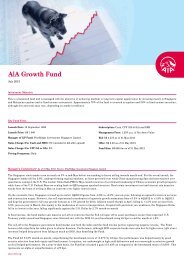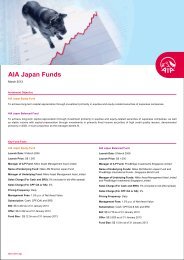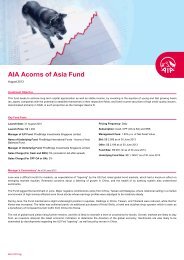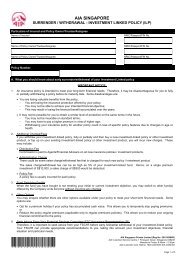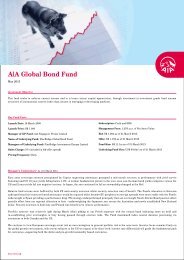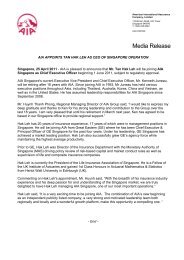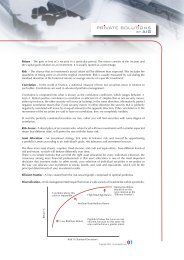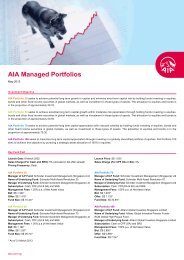ILPs - HSBC Singapore
ILPs - HSBC Singapore
ILPs - HSBC Singapore
- No tags were found...
You also want an ePaper? Increase the reach of your titles
YUMPU automatically turns print PDFs into web optimized ePapers that Google loves.
Contents02Introduction to Investment-Linked Insurance Plans (<strong>ILPs</strong>)07How <strong>ILPs</strong> Work11Insurance Protection12Investment Returns14Fees and Charges15Key Questions to Ask & Documents to Note18Dispute Resolution20Conclusion01YOUR GUIDE TOINVESTMENT-LINKEDINSURANCE PLANS
INTRODUCTION TO INVESTMENT-LINKED INSURANCE PLANS (ILPS)Investment-linked insurance plans started gaining popularity in <strong>Singapore</strong>from the early 1990s. Similar plans around the world have been marketedwidely for more than 30 years.What is an ILP?An ILP is a life insurance policy which provides a combination of protectionand investment. Premiums buy life insurance protection and investmentunits in professionally managed investment-linked fund(s).<strong>ILPs</strong> do not provide guaranteed cash values. The value of the ILP dependson the price of the underlying units, which in turn depends on how theinvestments in the fund perform. Fees, expenses and insurance chargesfor an ILP are paid for through a deduction of the premium and/or saleof purchased units.<strong>ILPs</strong> can be broadly classified into two categories:Single premium <strong>ILPs</strong> where premium is payable in one lump sum; andRegular premium <strong>ILPs</strong> where on-going premiums are payable.What is an Investment-Linked Fund?An investment-linked fund pools together the premiums paid bypolicyholders and invests in a portfolio of assets to achieve the fund sobjective. The price of each unit in a fund depends on how the investmentsin that fund perform. The fund may be managed by the insurer or externalfund manager(s).What are the Benefits of Purchasing <strong>ILPs</strong>?Flexibility<strong>ILPs</strong> offer you flexibility. For example, they allow you to top up yourinvestments on an ad-hoc or regular basis, make withdrawals and switchfunds. In addition, many regular premium <strong>ILPs</strong> give you the flexibility tovary your level of insurance coverage and allow premium holidays, duringwhich premium payments can be temporarily stopped without having toterminate your plan.02Note that there may be charges when you effect any of the aboveYOUR GUIDE TOINVESTMENT-LINKEDINSURANCE PLANS
changes. Do check the Policy Contract and Product Summary forinformation on the various charges.Choice of Funds<strong>ILPs</strong> let you choose from a wide range of investment-linked funds,managed by professional fund managers. It is important to select fund(s)that suit your financial goals and risk profile, for example, low, mediumor high risk. <strong>ILPs</strong> also allow you to move your money from one fund toanother to suit your financial situation and risk profile as they changeover time. Most insurers offer a limited number of free switches andcharge a nominal fee per switch thereafter. Before switching from onefund to another, check whether you are entitled to free switches and ifnot, how much you would need to pay for the switch.DiversificationThe investment-linked funds offer you access to different portfolios tohelp you diversify your investments and protect against the risk of "puttingtoo many eggs in one basket".Potential ReturnsWith <strong>ILPs</strong>, you can earn potentially higher returns over the long termcompared to other life insurance policies such as traditional whole lifeand endowment plans since you will enjoy the full benefit of any growthin the value of the units that have been allocated to you (please also seequestion below).Guaranteed InsurabilityOnce you purchase an ILP, you will enjoy guaranteed insurability for theduration of the plan, regardless of any changes in your health status.What are the Risks of Purchasing <strong>ILPs</strong>?Investment Returns are Not GuaranteedWhen you purchase an ILP, the investment risk will be borne entirely byyou. The performance of the funds is not guaranteed and the price ofthe units can rise or fall. As such, if a fund does not perform well, thecash and maturity values will be adversely affected.03YOUR GUIDE TOINVESTMENT-LINKEDINSURANCE PLANS
Investment Objective: Different investment-linked funds focus on differentasset classes, geographical regions or industry sectors, and have differentlevels of volatility. It is important to select a fund or funds that is/arecommensurate with your risk profile and investment objectives.Time Horizon: This refers to the period that you can stay invested beforeyou expect to cash out your investment. Regular premium <strong>ILPs</strong> are generallyregarded as long term insurance plans. A longer time horizon is particularlyimportant when investing in these types of plans as there are usuallysignificant charges in the early policy years.Are <strong>ILPs</strong> Suitable for Older People?As a general rule, older people have less pressing needs for life insurance— they may already have made adequate provision or may have fewerneeds once their children are financially independent.An important factor that comes into play for the older person is his orher ability to sustain premium payments if retirement is approaching.For an older person in this situation, who is unlikely to be able to continuewith his premium payments beyond retirement and for whom the primaryaim is investment, a regular premium ILP will not be a suitable option.The initial costs and the short term investment horizon will seriously limitthe potential returns and there will be other investment options that willbetter suit his or her needs.Similarly, if insurance protection is a significant objective, but cover isonly required for a very limited period, there are likely to be otherinsurance options that could be considered.What Are the Key Differences Between <strong>ILPs</strong> and Other LifeInsurance Plans?The key differences between <strong>ILPs</strong> and other life insurance plans, such astraditional whole life, endowment and term plans, are summarised inthe following table:05YOUR GUIDE TOINVESTMENT-LINKEDINSURANCE PLANS
InvestmentMandateInvestmentReturnsCash ValueILPSThe part of yourpremiums that areallocated for thepurchase of units willbe invested in yourchosen investmentlinkedfund. The fundis invested accordingto its specifiedinvestment objective.The performance ofthe fund can betracked through thedaily publication ofunit prices.The investment risk isusually borne entirelyby you.You may withdraw thecash value of the unitsthat have beenallocated to you. Notethat there may be asurrender charge. Aslife insurance policiesare long term plans,an early terminationof the policy usuallyinvolves high costs andthe cash value payablemay be less than thetotal premiums paid.Traditional Whole Life,Endowment & Term PlansAll of your premiums go intothe insurer’s participating fund.The insurer decides on theappropriate investmentportfolio for this fund aftertaking into account the nature,term and currency of theinsurer’s overall liabilities.The performance of the fundwill depend not only uponinvestment performance butalso upon other factors such asclaims experience (whether thisis more or less than anticipated)and expense levels.There are two categories ofbenefits - guaranteed and nonguaranteed.For guaranteedbenefits, the insurer bears theinvestment risk. However, fornon-guaranteed benefits, suchas bonuses, benefits depend onthe performance of theinsurer’s participating fund.Whole life and endowmentplans guarantee a minimumcash value usually after a fewyears’ premiums have been paid.However, note that as lifeinsurance policies are long termplans, an early termination ofthe policy usually involves highcosts and the cash value payablemay be less than the totalpremiums paid.Term plans do not have any cashvalue.06YOUR GUIDE TOINVESTMENT-LINKEDINSURANCE PLANS
BonusesPremiumBreakdownILPSNo bonuses arepayable. The value ofyour ILP depends onthe performance ofyour chosen funds.The amount of thepremium used forinsurance coverage,other charges and thepurchase of units areunbundled andtransparent. They aredisclosed in theProduct Summary andPolicy Contract.Traditional Whole Life,Endowment & Term PlansFor participating whole life andendowment plans, bonuses maybe payable depending on theinsurer’s profits. Bonuses arenot guaranteed. However, oncethey are declared by the insurer,they become guaranteedadditions to the plans.For term plans, bonuses are notpayable as these plans provideprotection only and do not haveany investment/savings element.The premium amount used forinsurance coverage, othercharges and investment arebundled up. They are notseparately identified in theProduct Summary and PolicyContract.HOW <strong>ILPs</strong> WORKDo I Pay A One-Time Premium or Do I Need to Pay Regularly?<strong>ILPs</strong> can be broadly classified into two categories:Single Premium <strong>ILPs</strong>In a single premium ILP, you pay a lump sum amount to purchase unitsin a fund.Regular Premium <strong>ILPs</strong>In a regular premium ILP, you pay premiums on a regular basis such asmonthly, quarterly, semi-annually or annually.In addition to single and regular premium payments, most plans give youthe option of investing an additional amount to your ILP at any time.This additional amount (known as a top-up premium) can be investedon a regular or ad-hoc basis. Some single premium <strong>ILPs</strong> offer you the07YOUR GUIDE TOINVESTMENT-LINKEDINSURANCE PLANS
option of making top-ups at specific intervals. These options are commonlyknown as recurring single premium options .Can I Invest With My Central Provident Fund (CPF) Savings?Premiums and top-ups can be made with CPF savings if the ILP is includedunder the CPF Investment Scheme. Since January 2001, only single premiumplans have been allowed under the CPF Investment Scheme. However,CPF members who have purchased regular premium plans prior to 2001can continue to have the regular premiums paid from their CPF savings.What are Offer and Bid Prices?Premiums are used to purchase units in the investment-linked fund(s) ofyour choice. The offer price is the price that is used to purchase units. Forexample, if the offer price is $1 and the whole of a $1,000 premium isused to buy units, it will buy 1,000 units.Units are then sold to pay for the various charges. The bid price is theprice that is used when units are sold. There is typically a 5% differencebetween bid and offer prices. For example, if the bid price is $0.95, 1,000units can be cashed in for $950. The difference between the bid and offerprices is used to help defray the insurer’s expenses.The cash value of the ILP depends on the number of units you have andthe bid price of those units. The bid price in turn depends on theperformance of the underlying investment-linked fund(s). The bid andoffer prices change on a daily basis.How Much of the Premium is Used to Purchase units?The full amount of premium paid may not always be allocated to purchaseunits. Before buying an ILP, it is important to find out what percentageof your premium would be used to purchase units. This information,commonly known as allocation rate , is available in the Product Summaryand/or Policy Contract.For most single premium plans and top-ups, 100% of your premium isused to purchase units. For regular premium plans, the amount of premiumused to purchase units will depend on the structure of the plan i.e.whether it has a "front-end" or "back-end" loading.08Front-End LoadingIn a front-end loaded plan, a certain amount of premiums would beYOUR GUIDE TOINVESTMENT-LINKEDINSURANCE PLANS
used to help defray the insurer s expenses such as distribution andadministration costs in the early years. These expenses decrease overtime. As such, less than 100% of premiums are allocated to purchaseunits in the initial years. The premium allocation increases over time untilit reaches 100%. Some insurers also provide premium allocations in excessof 100% in the later policy years, usually to reward policyholders whokeep their policies in force for the long term.For example, the allocation rates for a regular premium plan may be:15% in policy year 130% in policy year 250% in policy year 3100% in policy years 4 to 9102% thereafterThis means that 15% of the first year’s premium will be used to purchaseunits. In the second year, 30% will be allocated to purchase units, and50% for the third year. From the fourth to ninth year, the full premiumwill be used to buy units. From the tenth year onwards, 102% of thepremium will buy units.The diagram below illustrates how the allocation rate is applied to thefirst year premium for a regular premium ILP with front-end loading.ExamplePayment of PremiumPolicyholder pays premium.Annual premium of $1,200 ispaid.Allocation of PremiumInsurer allocates a portion of thepremium to purchase units ininvestment-linked fund(s) thatthe policyholder selects.Year 1 Allocation Rate: 15%. Thismeans that $180 (15% of $1,200)is allocated to purchase units.$1,020 (85% of $1,200) goes topay for initial expenses, whichincludes distribution andadministration costs.Purchasing UnitsUnits are purchased at the OfferPrice.Offer Price: $1Premium Allocated: $180Number of Units Purchased: 18009YOUR GUIDE TOINVESTMENT-LINKEDINSURANCE PLANS
Selling Units To CoverChargesUnits are sold at the Bid Price topay charges in the ILP. The BidPrice is usually lower than theOffer Price.Charges include charges forinsurance protection. Insurancecoverage charges arecommensurate with the amountand type of insurance protectionselected. As the risk of death,disability and illness increaseswith age, the insurance chargesincrease as the insured persongrows older.Bid Price: $0.95Insurance Charge: $50Number of Units Sold to PayInsurance Charge: 53 [$50 / $0.95]Remaining Number of Units inthe ILP: 127 [180 — 53]Cash value of the ILP: $121 [127units x bid price of $0.95Note: In the above example, the number of units is rounded to nearest whole number.Back-End LoadingUnder a back-end loaded plan, 100% of premiums are allocated topurchase units from the start. However, to help insurers defray distributionand administration costs, back-end charges are imposed if you wish tosurrender your plan, in whole or part, within a certain period of time.It should be noted that, although the premium allocation structure differsfor front-end and back-end loaded <strong>ILPs</strong>, the overall effect of the chargeswill be similar.How Are Unit Prices Computed?The frequency and methodology for computing unit prices vary fromfund to fund. Details can be found in the Product Summary and PolicyContract.10YOUR GUIDE TOINVESTMENT-LINKEDINSURANCE PLANSFor most <strong>ILPs</strong>, unit prices are computed based on forward pricing. Thismeans that the fund manager re-calculates the fund s net asset valuebased on the value of the investment-linked fund s underlying assets,after the market closes. The fund management charges are then deductedfrom the net asset value, and the balance is then divided by the total
number of units to derive the unit price. All ILP orders to purchase or sellunits are then settled based on the next computed unit price.INSURANCE PROTECTIONWhat Types of Insurance Protection Do <strong>ILPs</strong> Provide?<strong>ILPs</strong> provide insurance protection in the event of death. Additional benefitsmay include total and permanent disability, accidental death, criticalillness and hospitalisation coverage.Regular premium <strong>ILPs</strong> also generally give you the flexibility to vary thelevel of insurance coverage to meet your individual protection needs.However, an increase in coverage may be subject to the insurer’sunderwriting approval.It should be noted that the cost of insurance, based on your age, scopeand type of protection chosen, would be charged accordingly.Most single premium <strong>ILPs</strong> provide lower levels of insurance protectionas compared to regular premiums <strong>ILPs</strong>.Does the Cost of Insurance Increase with Age?Yes, it is an inescapable fact of life that from your 30s onwards there is,year by year, an increasing risk of death, disability or of contracting acritical illness. This increasing risk of claim has to be factored into thecalculation of the premiums for any life insurance product.Do I Need to Pay Higher Premiums as I Get Older?Not necessarily. Most life insurance products, including regular premium<strong>ILPs</strong>, are designed so that the premium you pay remains level throughoutthe life of the policy. For most regular premium <strong>ILPs</strong>, the premium, whichis usually payable monthly, is used to buy units in your chosen investmentlinkedfund. Units are then sold to pay for the insurance cover that month.Whilst these insurance coverage charges increase year by year, the premiumthat you pay — that is, the sum of money that actually leaves your bankaccount each month — will have been determined with the expectation11YOUR GUIDE TOINVESTMENT-LINKEDINSURANCE PLANS
Your risk preference — and, therefore, the appropriate fund — may wellchange during the lifetime of your policy as your time horizons shorten.As a general rule, the closer one gets to the time when the value of thepolicy will be realised, the less risk one wishes to take.For investments under the CPF Investment Scheme, the CPF assigns a riskclassification to all participating ILP funds.The following are some of the more common types of funds availablealong with an indication of their risk characteristics. The risk classificationcan only be a very broad guide since the risks associated with any fundwill depend upon how, precisely, it is invested. For example, a Bond Fundspecialising in low investment grade bonds will be a high risk investment.More information on the risk classification of funds authorised to participatein the CPF Investment Scheme can be found on the CPF website.Type General Description RiskCategoryMinimumTimeHorizon*Equity FundsPrimarily invested incompany stocks withthe general aim ofcapital appreciationMedium toHigh10 yearsplusIncome, FixedInterest andBond FundsInvested in corporatebonds, governmentsecurities and otherfixed incomeinstrumentsMedium4 years plusCash FundsSometimes known asMoney Market Funds —invested in cash, bankdeposits and othermoney marketinstrumentsLowUp to3 yearsBalanced FundsCombining equityinvestment with fixedinterest instrumentsMedium4 yearsplusGeographicallySpecialisedFundsInvestments restrictedto a particular countryor regionHigh10 yearsplus* Please check the allocation rate of your ILP as not all premiums may be invested (seepage 8). Also note that actual returns would depend on the performance of the respectiveinvestment-linked fund(s).13YOUR GUIDE TOINVESTMENT-LINKEDINSURANCE PLANS
What Happens If I Find that the Fund is No Longer Appropriate?You would normally have the flexibility to move part or all of yourmoney from one fund to another (known as fund switching). Whenselecting or switching investment-linked fund(s), it is important thatyou take your risk profile, investment objective and time horizon intoconsideration.How Would I Know If a Fund is Performing Well?You can monitor the investment performance of investment-linkedfunds by checking the unit prices regularly. Unit prices of investmentlinkedfunds are published in a number of publications including TheStraits Times, The Business Times and Lianhe Zaobao. Some insurers alsopublish unit prices on their website. You should not make hasty decisionsjust by looking at the daily prices of the units you have invested. Youshould seek the advice of the insurance adviser.FEES AND CHARGESWhat are the Fees and Charges for <strong>ILPs</strong>?<strong>ILPs</strong> offered by different insurers will have varying charge structures.These charges provide the means through which the insurer recoups itsdistribution and administrative expenses and the cost of insurancecoverage. Details of all charges for a particular ILP can be found in theProduct Summary and Policy Contract of that plan.Broadly, the different types of fees and charges are as follows. Whileinsurers have the right to revise fees and charges over time, most policycontracts state the maximum that the insurer may charge. You shouldtake note of this when considering an ILP.Insurance Coverage ChargesThese are charges to provide for the cost of insurance coverage, forexample death coverage, under the plan. These charges can be on amonthly basis and are usually funded by sale of units.14The insurance coverage charges will depend on a number of factors,such as the amount of coverage, your age, gender and whether or notyou are a smoker. Insurance coverage charges increase with age.YOUR GUIDE TOINVESTMENT-LINKEDINSURANCE PLANS
Fund Management FeesThese are fees payable to the fund manager for management of thefund.Policy/ Administration ChargesThese are the fees for administration of the plan.Surrender ChargesYou may sell units in your ILP at any time. However there may be asurrender charge for partial or full encashing of units before a certainperiod of time. You should bear in mind that if you sell some of yourunits you should also review the level of insurance protection as theremaining units may not be adequate to sustain the level of cover thatyou had originally selected.Bid-Offer SpreadThis is the difference between the unit offer price and unit bid price.Units are purchased at offer price, and sold at bid price. The bid-offerspread helps to cover distribution costs, marketing and other generaladministration expenses.Fund Switching ChargeGenerally a limited number of fund switches are allowed each yearwithout charge, but subsequent switches will be subject to a charge.KEY QUESTIONS TO ASK & DOCUMENTS TO NOTEWhat Questions Should I Ask My Insurance Adviser WhenConsidering Whether to Buy an ILP?To determine the suitability of any life insurance plan to meet your needs,you should first go through a proper Financial Needs Analysis withyour insurance adviser. This is important as it will help to identify yourfinancial goals, protection needs, risk preference and affordability. After15YOUR GUIDE TOINVESTMENT-LINKEDINSURANCE PLANS
understanding this, your insurance adviser will be able to recommendsuitable products to meet your needs. The following are key questionsyou should ask your insurance adviser:Type of PlanWhat type of ILP is it e.g. single or regular premium, front-end or backendloaded?What are the benefits and risks of the plan?Do I have to monitor the investment?What kind of commitments do I have to make to ensure that the investmentis sustained in the long run?PremiumsWhat options do I have if I want to stop my premiums temporarily?What happens to my insurance coverage if I stop my premiums?For how long do I need to pay the premiums?ReturnsAre the returns guaranteed?What kind of investment risk am I exposed to for my returns?Can I lose some or all of my money in this plan?Insurance ProtectionWhat type of insurance protection is provided?What is the amount and period of coverage?Can I change the amount of coverage as my needs change?What are the costs involved?Funds16YOUR GUIDE TOINVESTMENT-LINKEDINSURANCE PLANSWhat are the types of funds available, their performance track recordand their charges?Who are the fund managers?Which funds suit my risk preference?Can I switch funds?
Fees and ChargesWhat are the fees and charges for the plan?Where can I find details of the fees and charges?Surrender and WithdrawalsWhat are the charges if I want to terminate my plan?Can I make partial withdrawals?What are the pros and cons when I terminate my plan?Review of My PlanWhat happens if my financial needs or personal circumstances changee.g. retirement or become unemployed?Market KnowledgeWhat are other insurers offering?How does your plan compare with other insurers’ plans?What Documents Should I Take Note Of?You will receive the following sales documents from your insuranceadviser before you purchase an ILP. It is important to read these documentsand understand the product before making a purchase:A Financial Needs AnalysisThis document is based upon the personal and financial information thatyou share with your insurance adviser, and is intended to help identifyyour financial goals, protection needs, risk preference and affordability.Your insurance adviser should also state the basis for his or her productrecommendation. You should discuss this basis with your adviser andassess if the recommended plan meets your needs.A Product SummaryThis describes the features, fees and charges of the plan you are purchasing.17YOUR GUIDE TOINVESTMENT-LINKEDINSURANCE PLANS
A Benefit IllustrationThis illustrates the benefits of the plan, both guaranteed and nonguaranteed,and the costs and charges associated with the ILP you arepurchasing, including distribution costs, which take into account thecommission the insurer will pay to your insurance adviser, and the chargesfor insurance coverage.Your Guide to Life InsuranceThis is a guide which gives general information about life insurance andthe types of products available.After you have bought your ILP, your insurer will send you a statement,at least once a year. This statement shows the value of units in the policy,transactions for the period and charges paid through the sale of units.It is advisable to review this statement together with your insuranceadviser to check if the ILP and fund(s) selected continue to be relevantto your needs.What If I Change My Mind After Purchasing An ILP?As with all life insurance policies, after purchasing an ILP you will have14 days to review your plan. If you decide that the plan is not suitablefor your needs, you can cancel it.The insurer will refund all of the premiums that you have paid (withadjustment for any change in the market value of the investments whichback the plan) less medical and other expenses the insurer has had topay. You will need to send the insurer a written notice within 14 daysfrom the date you receive your Policy Contract.DISPUTE RESOLUTIONWhat If I Have a Complaint About My ILP?18YOUR GUIDE TOINVESTMENT-LINKEDINSURANCE PLANSIf you have a complaint about your ILP, you should first refer the matterto your insurer or the insurance adviser who sold you the ILP. However,if you fail to reach an agreement, the Financial Industry Disputes ResolutionCentre (FIDReC) provides an independent alternative dispute resolutionscheme. You must lodge your complaint with FIDReC within six months
from the date when you failed to reach an agreement with your insurer.FIDReC is staffed by full-time employees who are familiar with insurancelaw and practice. FIDReC aims to tackle and sort out disputes in a fairand cost-efficient way. This should hopefully mean you avoid timeconsuming,stressful and costly legal proceedings.At present, FIDReC covers the following:Claims between insured persons and insurance companies: up to S$100,000per claimOther claims (including disputes between banks and consumers, capitalmarket disputes, third party claims and market conduct claims): up toS$50,000 per claimFIDReC’s rulings are final and binding on the financial institution, butnot on you. You may choose to accept or reject FIDReC’s decision. If youare unhappy with the ruling by FIDReC, you can choose to pursue legalaction or other options such as approaching the Consumers Associationof <strong>Singapore</strong>, the <strong>Singapore</strong> Mediation Centre or the Small Claims Tribunal.However, if you do accept FIDReC s ruling, you may lose your right toproceed with legal action against the financial institution.You can contact FIDReC at:112 Robinson Road#13-03 HB Robinson<strong>Singapore</strong> 068902Tel: 6327 8878 Fax: 6327 8488Email: info@fidrec.com.sgWebsite: www.fidrec.com.sg19YOUR GUIDE TOINVESTMENT-LINKEDINSURANCE PLANS
CONCLUSIONInvesting in an ILP requires careful evaluation of your risk profile, age,financial commitment and a good understanding of how <strong>ILPs</strong> work. Inthe case of regular premium <strong>ILPs</strong>, be aware that these are generallyregarded as long term insurance plans, and a longer time horizon isparticularly important as there are usually significant charges in the earlypolicy years. Exercise caution and seek professional advice before makinga purchase decision.20YOUR GUIDE TOINVESTMENT-LINKEDINSURANCE PLANSThere is a wide array of investment and insurance products in the market.It is important to understand and select products that best meet yourneeds. Your insurance adviser is required to disclose product informationand to have a reasonable basis for his or her recommendation. Work withyour insurance adviser to assess if an ILP is suitable for your needs, andreview your plan regularly to ensure that it meets your changing needs.
Life Insurance Association of <strong>Singapore</strong>20 Cross Street #02-07/08 China CourtChina Square Central<strong>Singapore</strong> 048422Tel: 6438 8900 Fax: 6438 6989Email: lia@lia.org.sgWeb: www.lia.org.sgConsumers Association of <strong>Singapore</strong>170 Ghim Moh Road #05-01Ulu Pandan Community Building<strong>Singapore</strong> 279621Tel: 6463 1811 Fax: 6467 9055Email: complaints@case.org.sgWeb: www.case.org.sg



